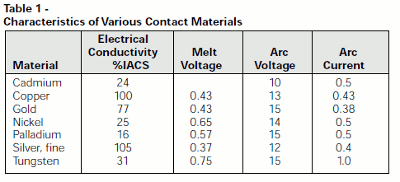Tyco Electronics has an interesting application note named Relay Contact Life. The Relay Contact Life document outlines the basics of relay contact selecting, properties of different contact material and strategies for protecting relay contacts.
There is no such thing as a universal relay contact. Relay contacts are available in a variety of metals and alloys, sizes and styles for a good reason. The relay user should select contact materials, ratings, and styles to meet, as precisely as possible, the requirements of a particular application. Failure to do so can result in contact problems and even early contact failure.
In many applications, the relay contacts may be subjected to punishing current surges which can drastically reduce their life if not properly selected for the application. Measure the current inrush of the circuit to be switched before specifying the relay.
The electrical life expectancy of general purpose and power relays is generally rated to be 100,000 operations minimum, while mechanical life expectancy may be many times higher. Contact life is terminated when the contacts stick or weld, or when excessive material is lost from one or both contacts and a good electrical make is not possible. The reason electrical life is rated so low compared with mechanical life is because contact life is application dependent. When a set of contacts switches a load of less than rated value, contact life may be significantly greater.
When you need to switch the signal very often consider the possibility to use Solid-State Relay. CP Clare application note Advantages of Solid-State Relays Over Electro-Mechanical Relays tells that electronic designs can take advantage of the improved performance of solid-state relays (SSRs) relative to that of electro-mechanical relays (EMRs) that perform the same circuit function. SSRs can usually be specified with confidence at actual load voltages and currents. Contact erosion is not a concern because there are no contacts. The absence of contacts and moving parts means that SSRs are not subject to arcing and do not wear out. SSRs have many good properties but they have also their disavantages, so they do not fit to all applications.

6 Comments
Chris says:
tyco is good company. are you working there too?
digital says:
I just like the valuable info you provide for your articles. I will bookmark your blog and take a look at once more here regularly. I’m rather sure I’ll be informed many new stuff right right here! Best of luck for the following!
Irving Tokunaga says:
I definitely wanted to jot down a simple word to appreciate you for all the pleasant strategies you are showing here.
cheap colour contact lenses says:
Asking questions are in fact pleasant thing if you are not understanding something totally, however
this article presents fastidious understanding even.
Tomi says:
Utilization categories
http://en.wikipedia.org/wiki/Utilization_categories
In electrical engineering utilization categories are defined by IEC standards and indicate the type of electrical load and duty cycle of the loads to ease selection of contactors and relays
Tomi Engdahl says:
Many people use a diode to suppress DC relay coils but it’s not the best solution. A properly rated transient voltage suppressor works better. Why? Because the low junction voltage of an ordinary diode prolongs the decay of the current circulating in the relay coil. This slows the release movement of the closed relay contacts and shortens the life of the contacts.